Seretide Evohaler 125
What Seretide Evohaler contains
• Each metered dose (ex valve) contains 25 micrograms of salmeterol (as salmeterol xinafoate) and 125 micrograms of fluticasone propionate. This is equivalent to a delivered dose (ex actuator) of 21 micrograms of salmeterol and 110 micrograms of fluticasone propionale.
• Each metered dose (ex valve) contains 25 micrograms of salmeterol (as salmeterol xinafoate) and 250 micrograms of fluticasone propionate. This is equivalent to a delivered dose (ex actuator) of 21 micrograms of salmeterol and 220 micrograms of fluticasone propionale.
• It also contains a propellant: norflurane (HFA-134a).
• Each inhaler provides 120 metered actuations (puffs).
What Seretide Evohaler looks like and contents of the pack
• Seretide Evohaler 125 consists of a pressurised metered-dose inhaler with a purple plastic device and a counter and a lighter purple cap.
• Seretide Evohaler 250 consists of a pressurised metered-dose inhaler with a purple plastic device and a counter and a lighter purple cap.
• The medicine is contained in a pressurised can, with a mouth piece and an ‘actuator'. The can has a counter attached to show you how many puffs of medicine you have left.
Product Licence holder
Procured from within the EU and repackaged by the Product Licence holder: Chemilines Ltd, Chemilines House, Alperton Lane, Wembley, HA0 1DX.
776-77 LEAFLET Seretide Evo 20160623
PACKAGE LEAFLET: INFORMATION FOR THE USER SERETIDE® 125 EVOHALER®
SERETIDE® 250 EVOHALER®
(salmeterol xinafoate/ fluticasone propionate)
Your medicine is known by the above name but will be referred to as Seretide throughout the following patient information leaflet. Please note that information regarding other strengths of Seretide Evohaler is also present in the below leaflet.
Read all of this leaflet carefully before you start taking this medicine because it contains important information for you.
- Keep this leaflet. You may need to read it again.
- If you have any further questions, ask your doctor or pharmacist.
- This medicine has been prescribed for you only. Do not pass it on to others. It may harm them, even if their symptoms and signs of illness are the same as yours.
- If you get any side effects talk to your doctor or pharmacist. This includes any possible side effects not listed in this leaflet. See section 4.
What is in this leaflet:
1 What Seretide is and what it is used for
2 What you need to know before you use Seretide
3 How to use Seretide
4 Possible side effects
5 How to store Seretide
6 Contents of the pack and other information
Other medicines and Seretide
Tell your doctor or pharmacist if you are taking, have recently taken, or might take any other medicines. This includes medicines for asthma or any medicines obtained without a prescription. This is because Seretide may not be suitable to be taken with some other medicines.
Tell your doctor if you are taking the following medicines, before starting to use Seretide:
• p blockers (such as atenolol, propranolol and sotalol). p blockers are mostly used for high blood pressure or other heart conditions.
• Medicines to treat infections (such as ritonavir, ketoconazole, itraconazole and erythromycin). Some of these medicines may increase the amount of fluticasone propionate or salmeterol in your body. This can increase your risk of experiencing side effects with Seretide, including irregular heart beats, or may make side effects worse.
• Corticosteroids (by mouth or by injection). If you have had these medicines recently, this might increase the risk of this medicine affecting your adrenal gland.
• Diuretics, also known as ‘water tablets' used to treat high blood pressure.
• Other bronchodilators (such as salbutamol).
• Xanthine medicines. These are often used to treat asthma.
Pregnancy and breastfeeding
If you are pregnant or breastfeeding, think you may be pregnant or are planning to have a baby, ask your doctor or pharmacist for advice before taking this medicine.
Driving and using machines
Seretide is not likely to affect your ability to drive or use machines.
Manufacturer
This product is manufactured by either of the below manufacturers-
• Glaxo Wellcome Production, Zone Industrielle 2, 23 rue Lavoisier, F-27000 Evreux, France
• Glaxo Wellcome S.A., Avenida Extremadura 3, E-09400 Aranda de Duero, Burgos, Spain.
|POM | PL 08747/0776 Seretide 125 Evohaler PL 08747/0777 Seretide 250 Evohaler
Leaflet revision date: 23 June 2016
Seretide® and Evohaler® are registered trade marks of Glaxo Group Ltd, UK.
776-77 LEAFLET Seretide Evo 20160623
Seretide contains two medicines, salmeterol and fluticasone propionate:
• Salmeterol is a long-acting bronchodilator. Bronchodilators help the airways in the lungs to stay open. This makes it easier for air to get in and out. The effects last for at least 12 hours.
• Fluticasone propionate is a corticosteroid which reduces swelling and irritation in the lungs.
The doctor has prescribed this medicine to help prevent breathing problems such as asthma.
You must use Seretide every day as directed by your doctor. This will make sure that it works properly in controlling your asthma.
Seretide helps to stop breathlessness and wheeziness coming on. However Seretide should not be used to relieve a sudden attack of breathlessness or wheezing. If this happens you need to use a fast-acting ‘reliever’ (‘rescue’) inhaler, such as salbutamol. You should always have your fast-acting ‘rescue’ inhaler with you.
Do not take Seretide:
If you are allergic to salmeterol, fluticasone propionate or to the other ingredient norflurane (HFA 134a).
Warnings and precautions
Talk to your doctor before using Seretide if you have:
• Heart disease, including an irregular or fast heart beat
• Overactive thyroid gland
• High blood pressure
• Diabetes mellitus (Seretide may increase your blood sugar)
• Low potassium in your blood
• Tuberculosis (TB) now, or in the past, or other lung infections
Always use this medicine exactly as your doctor or pharmacist has told you. Check with your doctor or pharmacist if you are not sure.
• Use your Seretide every day, until your doctor advises you to stop. Do not take more than the recommended dose. Check with your doctor or pharmacist if you are not sure.
• Do not stop taking Seretide or reduce the dose of Seretide without talking to your doctor first
• Seretide should be inhaled through the mouth into the lungs.
Adults and adolescents aged 12 years and over
• Seretide Evohaler 25/50 - 2 puffs twice a day
• Seretide Evohaler 25/125 - 2 puffs twice a day
• Seretide Evohaler 25/250 - 2 puffs twice a day
Children 4 to 12 years of age
• Seretide Evohaler 25/50 - 2 puffs twice a day
• Seretide is not recommended for use in children below 4 years of age.
Your symptoms may become well controlled using Seretide twice a day. If so, your doctor may decide to reduce your dose to once a day. The dose may change to:
• once at night - if you have night-time symptoms
• once in the morning - if you have daytime symptoms.
It is very important to follow your doctor's instructions on how many puffs to take and how often to take your medicine.
If you are using Seretide for asthma, your doctor will want to regularly check your symptoms. If your asthma or breathing gets worse tell your doctor straight away. You may find that you feel more wheezy, your chest feels tight more often or you may need to use more of your fast-acting ‘reliever' medicine. If any of these happen, you should continue to take Seretide but do not increase the number of puffs you take. Your chest condition may be getting worse and you could become seriously ill. See your doctor as you may need additional treatment.
Instructions for use
• Your doctor, nurse or pharmacist should show you how to use your inhaler. They should check how you use it from time to time. Not using the Seretide Evohaler properly or as prescribed may mean that it will not help your asthma as it should.
• The medicine is contained in a pressurised canister in a plastic casing with a mouthpiece.
• There is a counter on the back of the Evohaler which tells you how many doses are left. Each time you press the canister, a puff of medicine is released and the counter will count down by one.
• Take care not to drop the inhaler as this may cause the counter to count down.
Testing your inhaler
1 When using your inhaler for the first time, test that it is working.
Remove the mouthpiece cover by gently squeezing the sides with your thumb and forefinger and pull apart.
2 To make sure that it works, shake it well, point the mouthpiece away from you and press the canister to release a puff into the air. Repeat these steps, shaking the inhaler before releasing each puff, until the counter reads 120. If you have not used your inhaler for a week or more, release two puffs of medicine into the air.
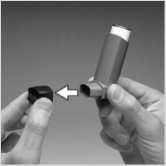
Using your inhaler
It is important to start to breathe as slowly as possible just before using your inhaler.
1 Stand or sit upright when using your inhaler.
2 Remove the mouthpiece cover (as shown in the first picture). Check inside and outside to make sure that the mouthpiece is clean and free of loose objects.
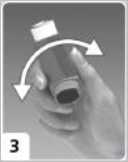
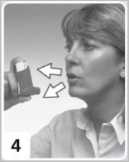
3 Shake the inhaler 4 or 5 times to ensure that any loose objects are removed and that the contents of the inhaler are evenly mixed.
4 Hold the inhaler upright with your thumb on the base, below the mouthpiece. Breathe out as far as is comfortable.
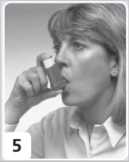
5 Place the mouthpiece in your mouth between your teeth. Close your lips around it. Do not bite.
6 Breathe in through your mouth slowly and deeply. Just after starting to breathe in, press firmly down on the top of the canister to release a puff of medicine. Do this while still breathing in steadily and deeply.
8 Wait about half a minute between taking each puff of medicine and then repeat steps 3 to 7.
7 Hold your breath, take the inhaler from your mouth and your finger from the top of the inhaler. Continue holding your breath for a few seconds, or as long as is comfortable.
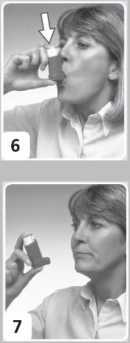
9 Afterwards, rinse your mouth with water and spit it out, and/or brush your teeth. This may help to stop you getting thrush and becoming hoarse.
10 After use always replace the mouthpiece cover straight away to keep out dust. When the mouthpiece cover is fitted correctly it will ‘click’ into position. If it does not ‘dick’ into place, turn the mouthpiece cover the other way round and try again. Do not use too much force.
Do not rush steps 4, 5, 6 and 7. It is important that you breathe in as slowly as possible just before using your inhaler. You should use your inhaler whilst standing in front of a mirror for the first few times. If you see “mist” coming from the top of your inhaler or the sides of your mouth, you should start again from step 3.
As with all inhalers, caregivers should ensure that children prescribed Seretide Evohaler use correct inhalation technique, as described above.
If you or your child find it difficult to use the Evohaler, either your doctor or other healthcare provider may recommend using a spacer device such as the Volumatic0 or AeroChamber Plus0 with your inhaler. Your doctor, nurse, pharmacist or other healthcare provider should show you how to use the spacer device with your inhaler and how to care for your spacer device and will answer any questions you may have.
It is important that if you are using a spacer device with your inhaler that you do not stop using it without talking to your doctor or nurse first. It is also important that you do not change the type of spacer device that you use without talking to your doctor. If you stop using a spacer device or change the type of spacer device that you use your doctor may need to change the dose of medicine required to control your asthma. Always talk to your doctor before making any changes to your asthma treatment.
Older children or people with weak hands may find it easier to hold the inhaler with both hands. Put the two forefingers on top of the inhaler and both thumbs on the bottom below the mouthpiece. A special device called a Haleraid® may also make it easier.
You should get a replacement when the counter shows the number 020. Stop using the inhaler when the counter shows 000 as any puffs left in the device may not be enough to give you a full dose. Never try to alter the numbers on the counter or detach the counter from the metal canister.
Cleaning your inhaler
To stop your inhaler blocking, it is important to clean it at least once
a week.
To clean your inhaler:
• Remove the mouthpiece cover.
• Do not remove the metal canister from the plastic casing at any time.
• Wipe the inside and outside of the mouthpiece and the plastic casing with a dry cloth or tissue.
• Replace the mouthpiece cover. It will ‘click’ into place when fitted correctly. If it does not ‘click’ into place, turn the mouthpiece cover the other way round and try again. Do not use too much force.
Do not put the metal canister in water.
If you use more Seretide than you should
It is important to use the inhaler as instructed. If you accidentally take a larger dose than recommended, talk to your doctor or pharmacist. You may notice your heart beating faster than usual and that you feel shaky. You may also have dizziness, a headache, muscle weakness and aching joints.
If you have used larger doses for a long period of time, you should talk to your doctor or pharmacist for advice.
This is because larger doses of Seretide may reduce the amount of steroid hormones produced by the adrenal gland.
If you forget to use Seretide
Do not take a double dose to make up for a forgotten dose. Just take your next dose at the usual time.
If you stop using Seretide
It is very important that you take your Seretide every day as directed. Keep taking it until your doctor tells you to stop. Do not stop or suddenly reduce your dose of Seretide. This could make your breathing worse.
In addition, if you suddenly stop taking Seretide or reduce your dose of Seretide this may (very rarely) cause you to have problems with your adrenal gland (adrenal insufficiency) which sometimes causes side effects.
These side effects may include any of the following:
• Stomach pain
• Tiredness and loss of appetite, feeling sick
• Sickness and diarrhoea
• Weight loss
• Headache or drowsiness
• Low levels of sugar in your blood
• Low blood pressure and seizures (fits)
When your body is under stress such as from fever, trauma (such as a car accident), infection, or surgery, adrenal insufficiency can get worse and you may have any of the side effects listed above.
If you get any side effects, talk to your doctor or pharmacist. To prevent these symptoms occurring, your doctor may prescribe extra corticosteroids in tablet form (such as prednisolone).
If you have any further questions on the use of this medicine, ask your doctor, nurse or pharmacist.
4 POSSIBLE SIDE EFFECTS
Like all medicines, this medicine can cause side effects, although not everybody gets them. To reduce the chance of side effects, your doctor will prescribe the lowest dose of Seretide to control your asthma.
Allergic reactions: you may notice your breathing suddenly gets worse immediately after using Seretide. You may be very wheezy and cough or be short of breath. You may also notice itching, a rash (hives) and swelling (usually of the face, lips, tongue or throat), or you may suddenly feel that your heart is beating very fast or you feel faint and light headed (which may lead to collapse or loss of consciousness). If you get any of these effects or if they happen suddenly after using Seretide, stop using Seretide and tell your doctor straight away. Allergic reactions to Seretide are uncommon (they affect less than 1 person in 100).
Other side effects are listed below:
Very Common (affects more than 1 person in 10)
• Headache - this usually gets better as treatment continues.
• Increased number of colds have been reported in patients with COPD.
Common (affects less than 1 person in 10)
• Thrush (sore, creamy-yellow, raised patches) in the mouth and throat. Also sore tongue and hoarse voice and throat irritation. Rinsing your mouth out with water and spitting it out immediately and/or brushing your teeth after taking each dose of your medicine may help. Your doctor may prescribe an antifungal medication to treat the thrush.
• Aching, swollen joints and muscle pain.
• Muscle cramps.
The following side effects have also been reported in patients with Chronic Obstructive Pulmonary Disease (COPD):
• Pneumonia and bronchitis (lung infection). Tell your doctor if you notice any of the following symptoms: increase in sputum production, change in sputum colour, fever, chills, increased cough, increased breathing problems.
• Throat irritation. Rinsing your mouth out with water and spitting it out immediately after taking each puff may help.
• Bruising and fractures.
• Inflammation of sinuses (a feeling of tension or fullness in the nose, cheeks and behind the eyes, sometimes with a throbbing ache)
• A reduction in the amount of potassium in the blood (you may get an uneven heartbeat, muscle weakness, cramp).
Uncommon (affects less than 1 person in 100)
• Increases in the amount of sugar (glucose) in your blood (hyperglycaemia). If you have diabetes, more frequent blood sugar monitoring and possibly adjustment of your usual diabetic treatment may be required.
• Cataract (cloudy lens in the eye).
• Very fast heartbeat (tachycardia).
• Feeling shaky (tremor) and fast or uneven heart beat (palpitations) - these are usually harmless and get less as treatment continues.
• Chest pain.
• Feeling worried (this effect mainly occurs in children).
• Disturbed sleep.
• Allergic skin rash.
Rare (affects less than 1 person in 1000)
• Breathing difficulties or wheezing that get worse straight after taking Seretide. If this happens stop using your Seretide inhaler. Use your fast-acting ‘reliever’ inhaler to help your breathing and tell your doctor straight away.
• Seretide may affect the normal production of steroid hormones in the body, particularly if you have taken high doses for long periods of time. The effects include:
- Slowing of growth in children and adolescents
- Thinning of the bones
- Glaucoma
- Weight gain
- Rounded (moon shaped) face (Cushing’s Syndrome)
Your doctor will check you regularly for any of these side effects and make sure you are taking the lowest dose of Seretide to control your asthma.
• Behavioural changes, such as being unusually active and irritable (these effects mainly occur in children).
• Uneven heart beat or heart gives an extra beat (arrhythmias). Tell your doctor, but do not stop taking Seretide unless the doctor tells you to stop.
• A fungal infection in the oesophagus (gullet), which might cause difficulties in swallowing.
Frequency not known, but may also occur:
• Depression or aggression. These effects are more likely to occur in children.
Reporting of side effects
If you get any side effects, talk to your doctor or pharmacist. This includes any possible side effects not listed in this leaflet. You can also report side effects directly via the Yellow Card Scheme at: www.mhra.gov.uk/yellowcard.
By reporting side effects you can help provide more information on the safety of this medicine.
5 HOW TO STORE SERETIDE
• KEEP OUT OF THE SIGHT AND REACH OF CHILDREN.
• Do not store above 25°C.
• Pressurised canister. Do not pierce or burn the canister even when empty.
• The canister contains a pressurised liquid. Do not expose to temperatures higher than 50°C, protect from direct sunlight.
• As with most inhaled medicinal products in pressurised canisters, the therapeutic effect of this medicinal product may decrease when the canister is cold.
• Do not use after the expiry date printed on the carton label or canister.
• Clean your inhaler on a weekly basis as described in the section “Cleaning your inhaler”.
• If your doctor tells you to stop using the inhaler, please take it back to the pharmacist for safe disposal. Only keep the inhaler if your doctor tells you to.